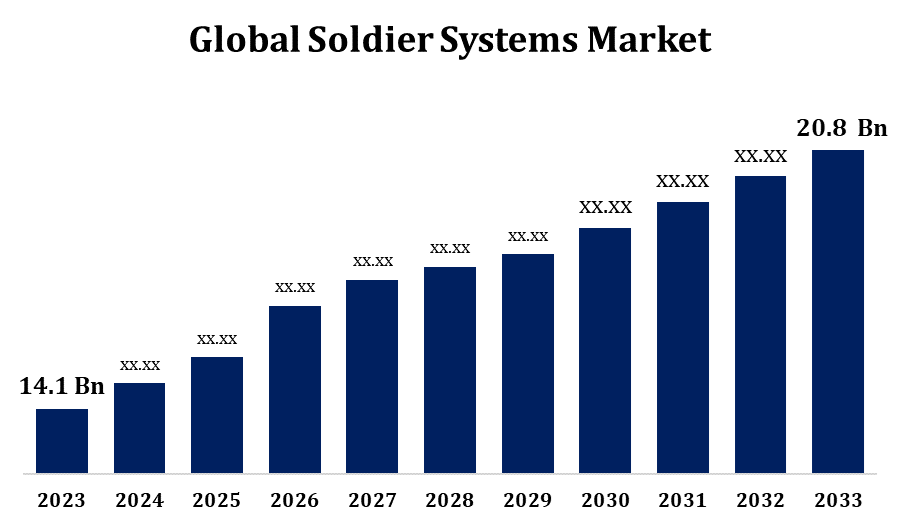Global Soldier Systems Market Size, Share, and COVID-19 Impact Analysis, By Equipment (Personal Protection, Communication, Navigation & Targeting), By Application (Combat Operations, Surveillance and Reconnaissance, Training and Simulation, Others), By End Use (Military, Government and Law Enforcement), and By Region (North America, Europe, Asia-Pacific, Latin America, Middle East, and Africa), Analysis and Forecast 2023 - 2033
Industry: Aerospace & DefenseGlobal Soldier Systems Market Insights Forecasts to 2033
- The Soldier Systems Market Size was valued at USD 14.1 Billion in 2023.
- The Market Size is Growing at a CAGR of 3.96% from 2023 to 2033.
- The Worldwide Soldier Systems Market Size is Expected to reach USD 20.8 Billion By 2033.
- Asia Pacific is Expected to Grow the fastest during the forecast period.

Get more details on this report -
The Global Soldier Systems Market Size is expected to reach USD 20.8 billion by 2033, at a CAGR of 3.96% during the forecast period 2023 to 2033.
The Soldier Systems Market is a rapidly growing sector that focuses on providing advanced technologies and equipment to enhance the effectiveness, safety, and efficiency of military personnel. This includes a wide range of products such as protective gear, communication devices, weapons, and wearable technologies designed to improve soldiers' operational performance in diverse environments. The market has seen significant advancements in smart technologies, like exoskeletons, augmented reality (AR) systems, and integrated communication systems. Rising defense budgets, increasing geopolitical tensions, and the adoption of cutting-edge innovations are driving demand for soldier systems globally. The market is expected to continue growing due to the increasing need for enhanced soldier protection, mobility, and connectivity, particularly in modern warfare scenarios and peacekeeping missions.
Soldier Systems Market Value Chain Analysis
The Soldier Systems Market value chain consists of several key stages, starting with research and development (R and D) to design innovative technologies tailored for military use. This is followed by the manufacturing phase, where components like protective gear, wearable devices, weapons, and communication systems are produced. Key suppliers of raw materials, electronics, textiles, and advanced materials play a crucial role in this stage. Once the products are manufactured, they move to distribution and logistics, which involves the integration of systems and equipment for military units. The final stage is deployment, where soldiers receive training on the systems and use them in operational environments. Throughout the value chain, collaboration between defense contractors, government agencies, and technology firms ensures the efficient production and delivery of advanced soldier systems.
Soldier Systems Market Opportunity Analysis
The Soldier Systems Market presents significant growth opportunities driven by advancements in technology and evolving defense needs. The integration of wearable technologies, such as exoskeletons, augmented reality (AR), and smart helmets, offers new possibilities for enhancing soldier performance and situational awareness. As modern warfare becomes more complex, there is rising demand for advanced communication systems, drones, and robotics to improve operational efficiency. Additionally, the increasing need for enhanced protection, mobility, and survivability in harsh environments opens opportunities for innovative protective gear and armor. The growing focus on defense modernization and rising defense budgets, especially in emerging markets, further fuels market growth. Collaborations between governments and defense contractors, along with advancements in cybersecurity for soldier systems, are expected to drive market expansion and innovation in the coming years.
Global Soldier Systems Market Report Coverage
| Report Coverage | Details |
|---|---|
| Base Year: | 2023 |
| Market Size in 2023: | USD 14.1 billion |
| Forecast Period: | 2023 -2033 |
| Forecast Period CAGR 2023 -2033 : | 3.96% |
| 2033 Value Projection: | USD 20.8 billion |
| Historical Data for: | 2019-2022 |
| No. of Pages: | 220 |
| Tables, Charts & Figures: | 108 |
| Segments covered: | By Application , By Equipment , By End Use ,and By Region |
| Companies covered:: | Rheinmetall, Thales Group, Textron, Leonardo, Lockheed Martin, Hensoldt, Elbit Systems, Korea Aerospace Industries, Raytheon Technologies, Northrop Grumman, L3Harris Technologies, SAAB, General Dynamics, BAE Systems, Oshkosh Defense |
| Pitfalls & Challenges: | COVID-19 Empact,Challenges, Future, Growth, & Analysis |
Get more details on this report -
Market Dynamics
Soldier Systems Market Dynamics
Progress in Military Technology to drive the market growth
Advancements in military technology are key drivers of growth in the Soldier Systems market. Innovations like wearable exoskeletons, augmented reality (AR) systems, and enhanced communication tools are transforming how soldiers operate in the field. These technologies improve mobility, increase situational awareness, and enhance soldiers' overall performance in combat and peacekeeping missions. Furthermore, developments in materials science, such as lighter and more durable protective gear, are offering better protection against diverse threats. The integration of advanced robotics and autonomous systems also plays a crucial role in augmenting soldier capabilities. As defense forces worldwide prioritize modernization to meet new challenges, the demand for cutting-edge soldier systems continues to rise, driving market expansion. Additionally, cybersecurity advancements ensure the safe and reliable use of these systems in complex operational environments.
Restraints & Challenges
One of the key obstacles is the high cost of advanced technologies, which can limit procurement by defense forces with constrained budgets. Additionally, the integration of complex systems, such as wearable technologies, exoskeletons, and communication tools, often requires significant training and adaptation for soldiers, which can be time-consuming and costly. The reliability and durability of these systems in harsh operational environments also pose challenges, as technological malfunctions or failures can compromise soldier safety and mission success. Moreover, the evolving nature of warfare and the rapid pace of technological advancements require continuous updates and innovations, putting pressure on defense contractors. Finally, cybersecurity threats to integrated soldier systems are an ongoing concern, requiring robust security measures to protect sensitive military data.
Regional Forecasts North America Market Statistics

Get more details on this report -
North America is anticipated to dominate the Soldier Systems Market from 2023 to 2033. The United States, in particular, leads the market, investing heavily in modernizing its military capabilities with cutting-edge technologies such as wearable exoskeletons, advanced communication systems, and augmented reality (AR) solutions for enhanced soldier performance. The U.S. Department of Defense continues to prioritize soldier protection, mobility, and situational awareness, driving demand for innovative systems. Additionally, strong collaborations between government agencies, defense contractors, and tech companies foster the development and deployment of next-generation soldier systems. Canada also contributes to the market, focusing on modernizing its defense capabilities. As geopolitical tensions and defense needs evolve, North America's soldier systems market is expected to expand further.
Asia Pacific Market Statistics
Asia Pacific is witnessing the fastest market growth between 2023 to 2033. Technological innovations such as wearable devices, augmented reality (AR) systems, and advanced communication tools are gaining traction to improve soldier effectiveness in diverse operational environments. The growing focus on border security, counterterrorism, and regional conflicts is pushing demand for better soldier protection and mobility. Moreover, strategic partnerships between local governments and international defense contractors are accelerating the development of cutting-edge solutions. With increasing geopolitical tensions and defense priorities in the region, the Asia-Pacific soldier systems market is poised for continued growth in the coming years.
Segmentation Analysis
Insights by Equipment
The personal protection segment accounted for the largest market share over the forecast period 2023 to 2033. Advancements in materials science have led to the development of lighter, more durable armor and protective gear, such as ballistic vests, helmets, and body armor, that provide better protection against a variety of threats, including bullets, shrapnel, and environmental hazards. Additionally, innovations in wearable technologies, such as exoskeletons and smart clothing, are improving mobility and reducing fatigue, further contributing to the growth of this segment. The rising need for personal protection is fueled by evolving security threats, including cyber warfare, terrorism, and hybrid warfare tactics, which require soldiers to be more adaptable and resilient. As defense budgets increase, the demand for personal protection solutions is expected to continue growing.
Insights by Application
The combat operations segment accounted for the largest market share over the forecast period 2023 to 2033. Innovations in communication systems, such as secure radios and integrated network solutions, are allowing for better coordination and real-time intelligence sharing during operations. Wearable technologies, including augmented reality (AR) systems, provide soldiers with enhanced situational awareness, allowing them to make quicker, more informed decisions in dynamic environments. Additionally, advancements in drones, robotics, and autonomous systems are being integrated to support combat operations, improving both offensive and defensive capabilities. The growing focus on modernizing armed forces, combined with rising defense budgets and evolving warfare tactics, is expected to drive further growth in this segment. As combat scenarios become more complex, the demand for cutting-edge soldier systems for operations continues to rise.
Insights by End Use
The military segment accounted for the largest market share over the forecast period 2023 to 2033. Military forces are increasingly adopting advanced technologies to enhance operational efficiency, soldier safety, and mission success. Innovations such as wearable systems, exoskeletons, and smart helmets are improving soldier mobility and protection, while augmented reality (AR) and artificial intelligence (AI) are enhancing situational awareness and decision-making. Additionally, integrated communication networks are enabling seamless data sharing among soldiers, boosting coordination during missions. With rising geopolitical tensions, modernization initiatives, and growing defense budgets, militaries are investing heavily in cutting-edge soldier systems. This growth is further fueled by the need to address new and complex warfare challenges, such as cyber warfare and asymmetric conflicts. The military segment is expected to continue expanding as global defense priorities evolve.
Recent Market Developments
- In July 2024, Kopin Corporation has teamed up with Wilcox Industries to launch the groundbreaking FUSION CLAW, a head-mounted information system set to revolutionize military operations.
Competitive Landscape
Major players in the market
- Rheinmetall
- Thales Group
- Textron
- Leonardo
- Lockheed Martin
- Hensoldt
- Elbit Systems
- Korea Aerospace Industries
- Raytheon Technologies
- Northrop Grumman
- L3Harris Technologies
- SAAB
- General Dynamics
- BAE Systems
- Oshkosh Defense
- Others
Market Segmentation
This study forecasts revenue at global, regional, and country levels from 2023 to 2033.
Soldier Systems Market, Equipment Analysis
- Personal Protection
- Communication
- Navigation & Targeting
Soldier Systems Market, Application Analysis
- Combat Operations
- Surveillance and Reconnaissance
- Training and Simulation
- Others
Soldier Systems Market, End Use Analysis
- Military
- Government and Law Enforcement
Soldier Systems Market, Regional Analysis
- North America
- US
- Canada
- Mexico
- Europe
- Germany
- Uk
- France
- Italy
- Spain
- Russia
- Rest of Europe
- Asia Pacific
- China
- Japan
- India
- South Korea
- Australia
- Rest of Asia Pacific
- South America
- Brazil
- Argentina
- Rest of South America
- Middle East & Africa
- UAE
- Saudi Arabia
- Qatar
- South Africa
- Rest of the Middle East & Africa
Frequently Asked Questions (FAQ)
-
1.What is the market size of the Soldier Systems Market?The global Soldier Systems Market is expected to grow from USD 14.1 billion in 2023 to USD 20.8 billion by 2033, at a CAGR of 3.96% during the forecast period 2023-2033.
-
2.Who are the key market players of the Soldier Systems Market?Some of the key market players of the market are Rheinmetall, Thales Group, Textron, Leonardo, Lockheed Martin, Hensoldt, Elbit Systems, Korea Aerospace Industries, Raytheon Technologies, Northrop Grumman, L3Harris Technologies, SAAB, General Dynamics, BAE Systems, Oshkosh Defense.
-
3 Which segment holds the largest market share?The military segment holds the largest market share and is going to continue its dominance.
-
4.Which region dominates the Soldier Systems Market?North America dominates the Soldier Systems Market and has the highest market share.
Need help to buy this report?